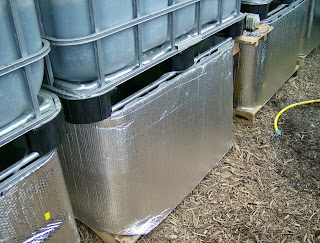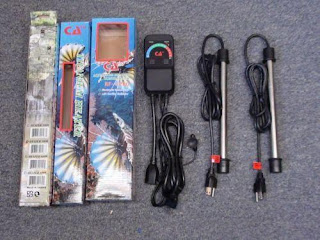I received my API Freshwater Test Kit a couple of weeks ago, and was able to test the nitrogen cycle of both tanks in relation to each units biological activity.
After running both Aquaponic tank systems for approx. 2 weeks without media in the growbeds, and another week with media, while having approx. 10 gold fish present in each tank for the entire duration I was able to see where my tanks ammonia, PH, Nitrite, & Nitrate levels were at in the cycle.
On October 8th, I had the following results tested at 80 degree water temperature.
Tank System 1:
PH: 8.8 PPM
NO2: 5.0 PPM
NO3: 10 PPM
NH3/4: .25 PPM
Tank System 2:
PH: 8.8 PPM
NO2: 5.0 PPM
NO3: 10-20 PPM
NH3/4: 0 PPM
Another test was performed on October 15 with the following resutls tested at 76 degrees for water temperature.
Tank System 1:
PH: 8.4 PPM
NO2: 0 PPM
NO3: 20 PPM
NH3/4: 0 PPM
Tank System 2
PH: 8.4 PPM
NO2: 2.0 PPM
NO3: 20 PPM
NH3/4: 0 PPM
As can be seen the tank systems are for the most part cycled, with the exception of the PH. which is high and is causing PH block for some of the nutrients in the system such as Iron, Calcium, & Potassium. A good organic pond fertilizer containing 10% iron, and Phosphate only was added to each tank to mitigate the iron deficiency, but due to the PH block this did not help.


I had added over several hours approx. 1/4 Gallon Muriatic acid to each system which temporarily lowered the PH to 7.8, after waiting 24 hours the systems were retested and due to the buffering action of the expanded shale, the PH crept back up to 8.4. I will continue to monitor all water quality on a weekly basis until the systems are stable, Muriatic Acid will continue to be added until I can get the PH down to 7.8, after which I will let it digress on it's own. More plants were added, some of which have shown signs of iron deficiency. I have an organic powdered chelated iron product ordered which should arrive sometime this week. I will add this to the systems and report back on the results.
Overall, plant growth has been outstanding, I have one Stevia plant which has added about 12" of growth in two weeks, and an Early Bird Tomato plant which has added approx. 6-8 inches of growth along with blooms in the same time frame. Kale has doubled in size, and herbs have had significant growth as well. Pepper plants are putting on more fruit as well.
More to follow.

















